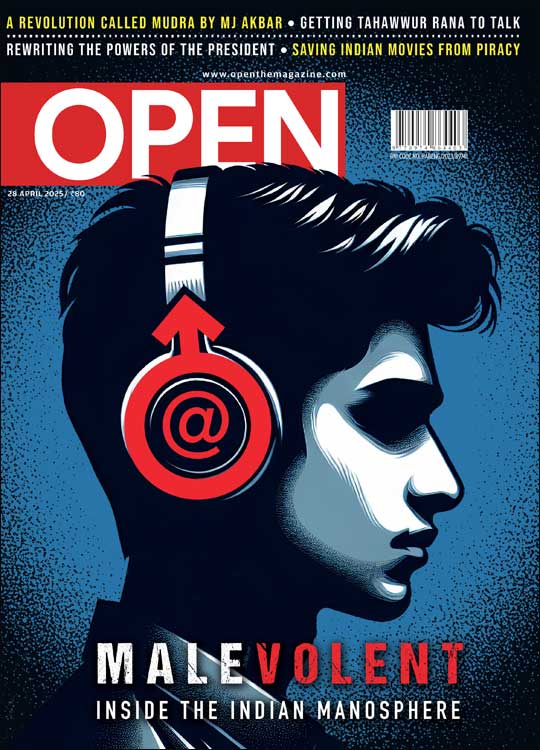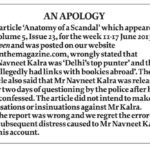Fear and foreboding in South Block
The Modi model of governance has banished power brokers and set in motion a new work culture. The inside story
 PR Ramesh and Ullekh NP
PR Ramesh and Ullekh NP
 PR Ramesh and Ullekh NP
|
17 Jul, 2014
PR Ramesh and Ullekh NP
|
17 Jul, 2014
/wp-content/uploads/2015/11/Cover-south-Block1.jpg)
The Modi model of governance has banished power brokers and set in motion a new work culture. The inside story
The new Government has prepared a dossier on lobbyists. In India, they could be arms dealers, middlemen, fixers and other shadowy figures who hang out in the lounges of five-star hotels and exclusive clubs of New Delhi waiting for the kill. Their presence at these privileged zones seems to have diminished. Nor are these men in their Armanis seen swaggering past Delhi’s corridors of power with sleek briefcases, or darting back to their luxury cars after dropping by at the ministerial offices of friends. For the time being, they seem to have crawled back to inactivity.
In a big departure, a top-bracket industrialist couldn’t meet a young minister recently for a private chat because the instructions of Prime Minister Modi forbade him from doing so. By Modi’s diktat, ministers must treat corporate leaders with respect and meet them in their offices, not at residences or hotels. The billionaire tycoon finally met a senior Cabinet minister, but in his office, and in the presence of bureaucrats. “No, we are not anti-corporate. On the other hand, we are pro-business but not pliable to machinations by top industrial houses, like the UPA Government used to be,” says a minister who adds that the NDA Government isn’t merely posturing here “to prove any point” but “is genuinely committed towards” creating an investor-friendly environment without interference and rule-flouting by big industrialists.
In the run-up to the Lok Sabha election earlier this year, the BJP had come under attack for being soft on some corporate houses, implying that once it came to power, the party would dole out sweet deals to these companies. “It is that perception that the Prime Minister wants to get rid of. ‘No malice to anyone, but no undue favours either’ is his policy,” says a senior BJP leader.
So far, so good.
In a government where the Prime Minister is the only boss, the message has been sent out time and again that the wishes of business houses won’t be the regime’s commands. “We mean business,” says the minister, refuting charges that the Government is indulging in a mere public relations exercise. If so, he asks, why slap penalties on companies perceived to be close to the BJP-led coalition, like the Adani Group and Reliance Industries Ltd?
His logic is that friendly business houses were never ‘touched’ during Congress rule. Reliance Industries Chairman Mukesh Ambani himself had jokingly referred to the UPA as “our own government”, as heard quoted by an aide. It wasn’t any secret that many UPA ministers were close to Reliance, which had also managed to have ‘favourable’ ministers in charge of petroleum and natural gas, its core business sector. Both Mani Shankar Aiyar and S Jaipal Reddy have been vocal about their opposition to tweaking rules to suit the company’s needs. And they paid a price for it.
Last week, India’s fair-trade watchdog Competition Com- mission of India (CCI) imposed a penalty of more than Rs 25 crore on Adani Gas for violating competition norms by abusing its dominant market position. The CCI ruling was on a case related to the supply and distribution of natural gas in Faridabad by Adani Gas Ltd—a unit of Adani Enterprises, which is part of the diversified Adani Group headed by its founder and chairman Gautam Adani, who is known to be a friend of Modi. “No such considerations are accorded by the current Government. Since coming to power, it has allayed the [fear] that it would allow itself to be run by corporates,” says a government official.
Similarly, Reliance Industries, which has been trying to warm up to the Government and earn the ‘goodwill’ it enjoyed of the previous regime, was slapped a fourth penalty this week for failing to meet gas-production targets at its Andhra offshore field. With this additional Rs 3,500 crore fine, the total sum of fines imposed on the company stands at Rs 14,200 crore over four financial years starting 1 April 2010. Explaining the Government’s move, Oil Minister Dharmendra Pradhan said in the Lok Sabha last Monday that the Centre’s profit share would increase by $195 million with these actions. A production- sharing contract allows RIL and its partners, BP Plc and Niko Resources, to deduct all expenses incurred on the project before sharing its profits on the sale of gas with the Government. The accounts have been controversial. During the UPA rule, the Oil Ministry under Jaipal Reddy’s watch had served violation notices to the company for a total fine of $1.79 billion ($457 million for 2010- 11, $548 million for 2011-12 and $792 million for 2012-13), but he was soon shifted out of the Ministry. RIL, for its part, has maintained that the government’s latest move contradicts the contract.
“Lobbying has never been this tough for businesses. It is frustrating for big business houses used to the luxury of walking into ministerial offices or homes of ministers and getting their work done. So far, the new Government has managed to keep them at bay. You never know how long they can resist corporate pressure and wooing. But as =of now, everybody within the Government is scared of being seen talking to corporates. There is fear of Modi,” says a Mumbai-based CEO of an IT firm.
While the Government refused to bow to demands by oil-marketing companies to raise gas prices, it has created consultation panels to ease cumbersome procedures for doing business in several key sectors such as power, transport and water. This means, argues the BJP minister, that Modi will not buckle under pressure or yield to lures, but will, at the same time, work towards ushering in a greater level-playing field for entrepreneurs.
The Government has deferred a gas price hike, saying the whole issue as well as the guidelines for gas pricing require a comprehensive discussion to take care of public interest. It is well known that demand for gas in the country far outstrips output, but prices have been kept low for crucial segments such as fertilisers and power.
INSIDE THE GOVERNMENT
Nripendra Misra, principal secretary to the Prime Minister, is hands-on and powerful, unlike principal secretaries during the UPA rule who were seen as inefficient. According to people close to the regime, he executes Modi’s insistence on the “vertical movement” of files and speed with which they are processed. “To and fro hurling of files is not there now. It is a big change from the days of the UPA, when files got stuck between bureaucrats and ministries over ego issues or lack of clarity on policy,” says a Government official. Misra also ensures ‘seamless’ communication between ministries over decisions. “He speaks to most ministers in chaste Hindi and leaves no chance for confusion about certain measures,” the official adds, emphasising that the former TRAI chairman also vets each Cabinet note and brings it to Modi’s attention before it goes to the Cabinet secretary. The new benchmark being set for effective governance is a maximum of four signatures to every file as it goes from a director- level officer to the minister.
Ministries have also been told not to seek legal opinions, often a ruse for delaying files in the past; such advice can be sought only if a clear case is made for it. Besides, if there are conflicts of interest between ministries, the officer concerned has been advised to walk over to the other one and try resolving the issue in person rather than have long letters being shot back and forth. Modi has adopted a ‘zero-tolerance approach’ to any unwanted delays in clearing files. This forces many ministers to spend close to 20 hours a day in office.
Unlike in the days of the NDA Government led by AB Vajpayee, who had to negotiate big egos and diverse views within his cabinet, Modi has a well-coordinated team at work, making Misra’s job much less abrasive than Brajesh Mishra’s (who held the twin positions of principal secretary and national security advisor). Back in those days, Vajpayee and Mishra had to strategise their moves in order to win majority backing of the Cabinet and Council of Ministers over key issues. For instance, to push forward with the disinvestment of some public-sector units, the duo had to first call a meeting of ministers such as Jaswant Singh, Yashwant Sinha and Arun Shourie, who favoured the action, to gain an edge over its opponents in the Cabinet such as LK Advani. Vajpayee and his team once even managed to secure the support of MM Joshi, typically a votary of Swadeshi politics, to take on the likes of Advani and Ram Naik. Ministers used to take part in debates in the alphabetical order of their names. Then Deputy Chairman of the Planning Commission KC Pant used to be the final member to make a statement. “There were very powerful ministers and party leaders in the Cabinet then. Now, Modi has a smoother run,” says a former bureaucrat who has worked closely with Vajpayee.
Under the previous dispensation, Cabinet ministers could walk in half-way through meetings or leave before they ended. But not anymore. Modi is the last one to enter a Cabinet meeting and the first to leave. Ministers such as Harsimrat Kaur Badal and Nirmala Sitharaman are the most ‘talkative’ ones in the current regime. Modi hears out each minister in a Cabinet session. When it comes to political issues, Home Minister Rajnath Singh is the one whose opinion is often sought by the Prime Minister; Arun Jaitley is given the floor when it comes to economic issues. Modi is intolerant of ministers who come up with frivolous suggestions. Nor are ministers allowed to flout etiquette or procedural propriety. According to people in the know, a request by HRD Minister Smriti Irani to raise an issue over the mid- day scheme for school children was declined because she had not gone through the process of taking suggestions from the PMO on a Cabinet note on the issue.
THE PMO
Modi has put in place a Prime Minister’s Office that is similar to the Chief Minister’s Office in Gujarat, where it served as the main centre of power, offering quick decisions on crucial matters, including big-ticket project clearances. However, unlike officials at his CMO, officers in the PMO neither remain low-key nor stay away from the media glare. They are, like the CMO staff, hardworking and available on call 24X7.
While Misra, a retired IAS officer of the 1967 batch from the Uttar Pradesh cadre, plays the pivotal role, one of Modi’s favourite officers, PK Mishra was brought in to assist him as additional principal secretary. A former agriculture secretary, Mishra is a 1972-batch retired IAS officer of the Gujarat cadre. He had served between 2001 and 2004 as principal secretary to Modi when he was the CM of Gujarat. He was chairman of the Gujarat Electricity Regulatory Commission after his retirement in 2008 for a five-year term. Mishra has a long association with the Prime Minister and has known him since his days as an RSS pracharak.
Others who work very closely with Modi include NSA Ajit Doval; Joint Secretary AK Sharma, a 1988 batch IAS officer of the Gujarat cadre who has deftly managed Modi’s showpiece Vibrant Gujarat summits; Public Relations Officer Jagdish Thakker; and IT expert Hiren Joshi, who handles the social media for Modi. Other junior officers include his favourites such as Sanjay Bhavsar, who is Modi’s point person on appointments.
Thanks to such a closely knit and cohesive team, Modi often ends up impressing rival politicians with his grasp of subjects under review. He will shortly name an IAS officer at the PMO to oversee media affairs.
POWER CENTRES
With his ascension as BJP President, Amit Shah is clearly the second- most powerful person in the NDA regime. He also takes a keen interest in running the Government, according to people close to the party’s affairs. “That he enjoys Modi’s blessings in no secret. Modi also expects him to come up with out-of-the-box ways to improve governance,” says one of them.
Shah, it is learnt, has made crucial suggestions to officials and ministers to envision projects and come up with ways to ease India’s myriad infrastructural bottlenecks. The Government is currently toying with the idea of ‘Israel-style’ implementation of infrastructure projects, by which it ropes in various arms of the State for civilian undertakings.
With the Modi Government laying a lot of emphasis on water, power and transport, many such projects are likely to take shape in the near future, say officials. The internal target of the Modi Government is to cover 75 per cent of India’s homes with round-the-clock power over the next five years. Suresh Prabhu, a former minister and power-sector expert, has been roped in to advise various ministerial panels and stakeholders in refurbishing the country’s power sector. While the Centre isn’t pleased with one of the BJP- led state governments for not cooperating well enough in aiding the generation of a higher quantum of electricity in the short term, it has put in place mechanisms to iron out differences between various states over generating and distributing extra power.
In addition, reforestation, Ganga cleaning and railway modernisation are also top priorities of the Government. Others include running trains to pilgrimage centres considered holy by Hindus, such as Badrinath, Kedarnath and so on. “Many officers are working in silence towards meeting many internal goals set by the Prime Minister,” says an official.
Shah, like Modi, will also be closely monitoring various government projects. At least one junior minister has disclosed that the BJP President doesn’t take kindly to sloppy work. Says a government official: “That Shah is watching every minister and how they work puts them on their toes. Besides Modi’s instructions, Shah’s capacity to monitor each and every person in the Government and his or her movement puts fear in the minds even of bureaucrats who could be approached by corporates.”
The BJP heavyweight, whose stature in the party has risen rapidly over the past year thanks to his proximity to Modi and his own skills at poll campaigning, and Finance Minister Jaitley have been closely watching the country’s coal sector—as part of efforts to reduce the shortage of this fossil fuel. The country’s coal production was 566 million tonnes last fiscal year, but its demand was in the range of 715-720 million. The Power Ministry recently launched its first major new project in at least five years at the Amrapali open cast pit in Jharkhand. The country has so far failed to raise output despite sitting on the fifth- biggest reserves in the world, making it the third-largest coal importer. The opening of this mine highlights the Modi Government’s priorities in the sector, Power Minister Piyush Goyal had said.
The Cabinet often has senior ministers chipping in with advice for junior colleagues. While External Affairs Minister Sushma Swaraj remains largely low-profile, since Modi steers foreign policy, it is Jaitley who often plays the mentor’s role for many colleagues such as Pradhan, Goyal and Sitharaman, as also Law Minister Ravi Shankar Prasad, among others, besides handling finance-related issues.
It helps that Jaitley was senior to most others in the Akhil Bharatiya Vidyarthi Parishad, the BJP’s students wing, as well as in the party. As Defence Minister, Jaitley knows only too well that he faces insurmountable odds to modernise the Soviet- era weaponry of a country that has in the recent past seen a lot of scams related to deals for the purchase of helicopters and other defence equipment. After a lull following an election year, defence manufacturers from across the globe have now arrived in the country, the world’s largest defence importer, peddling their products. “One has to take extreme care in the process of purchase. The Government’s tenacity will be tested as it goes ahead with replacing obsolete weaponry and buying new [equipment],” says a Defence Ministry official.
Meanwhile, the Government has earned negative publicity over the its refusal to name Gopal Subramaniam as a Supreme Court judge—the apex court expressed its displeasure over the controversy that ended with Subramaniam pulling out of the race. Similarly, the appointment of Y Sudershan Rao as chairperson of the Indian Council of Historical Research raised many eyebrows over his qualifications.
With Modi’s great expectations from his colleagues to work hard and preserve integrity, business houses accustomed to buying their way through to secure major gains are feeling the pinch. For them, a curtain has descended over Raisina Hill—and power has shifted from The Chambers and Belvederes to Shastri Bhavan and South Block.“It is a time of dread for them. The idea should be to get them used to it,” forewarns a senior bureaucrat.
The Modi model of governance abhors the secret hand.
About The Author
CURRENT ISSUE
MOst Popular
3

/wp-content/uploads/2025/04/Cover-Manosphere.jpg)











More Columns
‘Colonialism Is a Kind of Theft,’ says Abdulrazak Gurnah Nandini Nair
Bill Aitken (1934 – 2025): Man of the Mountains Nandini Nair
The Pink Office Saumyaa Vohra